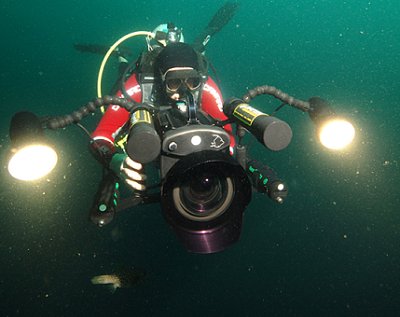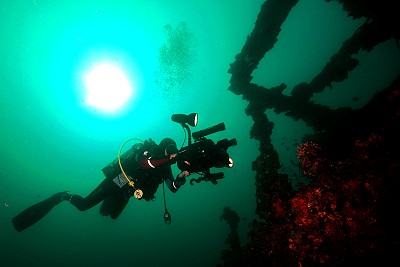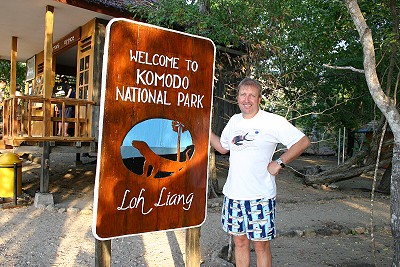 Danny van Belle is a renowned Belgian underwater photographer and videographer working with his wife as a "spotter" to document the beauty of marine life, particularly in the tropics. He was the president of the jury in the World Oceans Day 2014 contest organised by Mundus maris for young people to tell visual stories about the sea.
Danny van Belle is a renowned Belgian underwater photographer and videographer working with his wife as a "spotter" to document the beauty of marine life, particularly in the tropics. He was the president of the jury in the World Oceans Day 2014 contest organised by Mundus maris for young people to tell visual stories about the sea.
Returning from his latest exploratory trip to the Pacific, Mundus maris was able to interview Danny van Belle about his work and how it changed over time.
MM: You are doing fascinating work as a wildlife underwater photographer and videographer. Can you explain what made you chose such an unusual profession and how do you work?
DvB: It all happened during a holiday in Thailand in 1996. Attracted by the warm tropical waters of the Andaman Sea I decided to learn diving. I finished my PADI ‘Open Water’ course. This experience was overwhelming and resulted in the fact that in one year's time I did all the diving courses up to PADI ‘Open Water Instructor’. And I moved to Thailand to work there.
 The beauty of the underwater world was difficult to explain in words and so quite quickly I decided to take a video camera with me so I could share my feelings and emotions with non-divers.
The beauty of the underwater world was difficult to explain in words and so quite quickly I decided to take a video camera with me so I could share my feelings and emotions with non-divers.
After years working as an instructor, I decided to go full time for underwater videography. I can say to be a very lucky guy, who could turn his hobby into his profession.
MM: You have been diving in some of the same locations for many years. What change do you observe in the marine life and their ecosystems you document?
DvB: It is changing and it’s changing quickly!! As everything is happening underwater and not in the direct view of humankind people have no idea about the situation.
The Andaman sea, so magnificent 15 years ago, is now as good as dead and empty. Global warming of the oceans results in warmer seawater. The influence of ‘El Nîño’ resulted, a few years ago, in warmer seawater in the Andaman Sea, which triggered a stress reaction of the coral polyps. They expelled their zooxanthellae, unicellular flagellate protozoa, which normally live in symbiosis within the coral polyps and give them colour. This is called coral bleaching.
The results … over 95% of all hard corals died and there are almost no hard corals alive anymore. All this may seem not particularly impressive but let me put in another context ….
IMAGINE …… if the same happens in Belgium.
Due to human presence all flowers and all trees suddenly die (within the short span of one year). If in the whole of Belgium all flowers disappeared, if only skeletons of dead branches stayed behind on the trees, if not one tree had leaves. As result, all the bees would disappear as there would be no flowers anymore. No more butterflies as there would be no food anymore for them. The birds would die as there aren’t any trees in which to hide and nest. Fungi would conquer Belgium as rotten wood is a perfect place for them to develop and there would be plenty of it everywhere.
 WELL ………. This is how the Andaman Sea looks like now. Only skeletons of dead hard coral. No more small reef fishes darting around. They all disappeared. Slimy algae cover the dead coral polyps and coral branches. It looks like a graveyard.
WELL ………. This is how the Andaman Sea looks like now. Only skeletons of dead hard coral. No more small reef fishes darting around. They all disappeared. Slimy algae cover the dead coral polyps and coral branches. It looks like a graveyard.
The Andaman Sea is 20 times the surface of Belgium! This is “only” global warming, but there’s also overfishing.
In South-East Asia, as divers, we don’t see any sharks anymore on our dives. Some years ago, in Thailand, encounters with leopard sharks, sometimes also called zebra sharks (Stegostoma fasciatum), were frequent. These days, you’re lucky to see one. Statistics confirm that in 15 to 20 years from now, if trends continue, sharks will be extinct on our planet!
MM: You served as president of the jury of this year's youth competition initiated by Mundus maris to celebrate World Oceans Day, 8 June 2014. During the cultural soirée announcing the winners you spoke about the dramatic coral bleaching in the Andaman Sea in the last few years. What are the reasons?
DvB: The Andaman Sea is a shallow sea and so one of the most vulnerable. This is a place where the influence of global warming will be noticed first. Other South-East Asian countries (especially Indonesia) are lucky to have deepwater seas with lots of currents and flows connecting Indian Ocean & the Pacific Ocean.
The results of global warming can also be witnessed there already in shallow, current-protected reef areas where coral bleaching also occurs. In my opinion, global warming is the main reason for the current situations.
MM: Your work is centered on the beauty of marine life, the often amazing plants and animals that shape the biggest ecosystem on Earth, our Ocean. At the same time, many of those beautiful creatures suffer from overexploitation, habitat destruction pollution and other stress factors. Where can you still find those oases of beauty in the tropics or elsewhere and how can we protect them from going the way of the Andaman Sea or worse ?
DvB: Oases of sealife are indeed very hard to find. It’s sad to say, but humankind is failing them on all levels. In all national parks of Indonesia that I know people are still fishing. Rules are not enforced. Boats are anchoring everywhere. Lots of promises all around the world, but nothing or very little is really happening. Only a few very, personally-coordinated, actions have some results so far. The efforts of the Misool Eco Resort to protect an area in Rajah Ampat in Indonesia is remarkable in this respect. They have their own rangers and patrols. They have to work hard to keep out fishermen, but things improve in that region.
 The authorities in ‘tropical’ countries are often corrupt and little is done. Declaring certain regions as a national park doesn’t mean this area is really protected and under surveillance. I think less money should be given to official instances. Instead help should be offered for really protecting the national park areas: Supplying rangers, surveillance boats, scientific monitoring, help in educating local populations, site-specific protection programmes by small groups of people.
The authorities in ‘tropical’ countries are often corrupt and little is done. Declaring certain regions as a national park doesn’t mean this area is really protected and under surveillance. I think less money should be given to official instances. Instead help should be offered for really protecting the national park areas: Supplying rangers, surveillance boats, scientific monitoring, help in educating local populations, site-specific protection programmes by small groups of people.
MM: Many scientists and conservationists argue in favour of a big push towards more marine protected areas (MPAs) to cover at least 10% of the ocean. The State Parties to the Convention on Biological Diversity have set this target for 2020 and also wanted to establish networks of such MPAs to ensure there are corridors of protection for marine organisms to exist and adapt e.g. to climate change. The deadline of 2010 was missed, but there is now some progress. Do you have more first-hand experience with such protected zones?
DvB: There are protected areas, but most of the times the rules are not enforced. What’s the purpose of having a national park as big as Belgium, if you have one small boat and two rangers to keep an eye on it? Most of the time the rangers are not really tough as they come from the local population and overwhelmed by the task – mission impossible. It simply doesn’t work as far as I can notice.
I think only in the well-developed countries rules are more strictly implemented. Most of the tropical waters and seas with coral reefs are situated in the region with less developed countries and inadequate means to protect their marine wildlife against strong market forces for exploitation. Besides, they are not the big polluters responsible for global warming. How to make sure that national parks are also really well protected – we don't have convincing answers everywhere.
MM: Does your work carry a message for ordinary people, many of whom may never have the chance to see what you do in nature? Can people do something to protect marine life?
DvB: I’ve always tried to show the beauty and splendor of the marine world. Everyday all news on TV and media is negative. No positive signals! It’s always murder, bombs, wars, accidents, …. I hope when people can enjoy the beauty of nature a warm feeling stays behind. A feeling that will push them towards protecting our world and everything that lives on our planet.
MM: Some of your videos have won international prizes. You have also successfully set up an international festival for underwater photography and video, the HUGYCUP. Can you explain a little more?
DvB: Yes, my documentaries have been awarded worldwide. I’m the only person who has been awarded the ‘Golden Fin’ four times for best documentary at the World Festival of Underwater Images. Let’s say these are the ‘Oscars’ for underwater documentaries. Underwater imaging is my way to share my feelings and my impressions of what I experience.
 By organising the HUGYCUP I unite a lot of people interested in sharing this experience too. On the HUGYCUP platform, I also organise workshops in underwater videography & photography.
By organising the HUGYCUP I unite a lot of people interested in sharing this experience too. On the HUGYCUP platform, I also organise workshops in underwater videography & photography.
Some of the first participants are now great photographers writing articles for diving magazines, others make documentaries. In the end, we reach more and more people with whom we can share our love for the oceans.
MM: What was your greatest joy and what was your greatest sorry during your long career engaging with the sea?
DvB: One of the most emotional moments happened early this year. At the end of a dive in Ambon (Indonesia) we arrived in shallow water and found a bowmouth guitarfish (Rhina ancylostoma) captured by the locals. With a rope around its tail it was waiting for a certain death. The more than 2m long shark would probably only be ‘finned’ and the rest thrown away.
I ordered our diveguide, divemaster to negotiate with the locals about how much it would cost for us to buy the shark. I could buy this amazing fish for 750000 Rupiah (47 €). Our diveguide released the shark and gave it back its freedom. A magical moment and feeling our dive group shared. You can see the release of the shark here.
On the level of filming my greatest joy are three animals of which I was the first in the world to film video footage. The Hypselodoris zebrina nudibranch, the Kyonemichthys rumengani pygmy seadragon and the Histiophryne psychedelica psychedelic frogfish of which so far only 11 specimens have been spotted ever.
 My sorry ….. I’ve seen so far one dugong (manatee) in my life …… just killed attached by its tail on the back of a boat in Indonesia. Never seen one alive.
My sorry ….. I’ve seen so far one dugong (manatee) in my life …… just killed attached by its tail on the back of a boat in Indonesia. Never seen one alive.
My greatest sorry ….. Humankind seems not smart enough to keep Earth the paradise it once was. The changes that are happening in our world are going so fast that I’m fearing for the worst. Whenever I go back to a dive spot…. It never gets better, it always gets worse.
MM: What are your next projects?
DvB: From mid February till mid April 2015 I’ll be in Puerto Galera, Philippines, to coordinate the HUGYCUP. At the end of next year, I’ll be in Rajah Ampat, Indonesia, for two cruises between Sorong and Ambon discovering and filming the Dampier Strait and the Misool region. And this winter will be the time to work on a new documentary that should be launched in 2015.
MM: Thank you very much.
Mundus maris is proud to be among the sponsors of the 2015 HUGYCUP.. Cornelia E Nauen asked the questions, pictures are by his wife Caroline.
More info from Danny van Belle on his website at www.dannyvanbelle.com.









